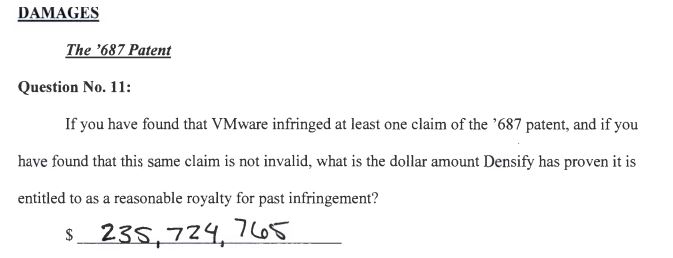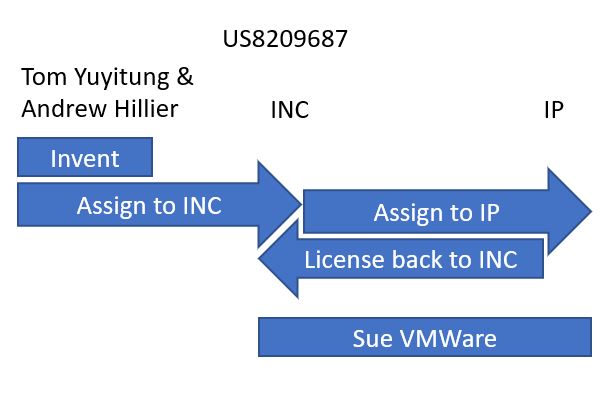Companies who play corporate games creating and shifting shell companies sometimes face serious consequences when painted into a corner. In Cirba, Inc. (DBA Densify) and Cirba IP v. VMWare (D. Del. 2020), a jury sided with the patentee Cirba Inc. and awarded $235 million in damages. That verdict though has been vacated because Cirba Inc.’s subsidiary Cirba IP actually owns the patent rights. According to the filings, the transfer to Cirba IP was done for “uncontroversial tax reasons.”
Although the jury awarded the money, Judge Leonard P. Stark did not enter judgment for the millions. Rather, Judge Stark found that Cirba Inc. (“INC”) did not actually have rights to enforce the patent and thus dismissed the case for lack of Article III standing. According to Stark, INC had transferred rights to its wholly owned subsidiary Cirba IP (“IP”). And, although IP was a co-plaintiff Judge Stark ordered a new trial — finding that the presence of INC so materially changed the trial that “it is quite probably that the outcome would … have been different.” Basically, the theme of INC’s case was about competition against the much larger VMWare, but IP is only a patent holder. Thus, all is not lost for Cirba, but juries are quite unpredictable.
A timeline of events is shown above, and one basic question for standing is whether that license-back included enough grit to give INC standing.
The new trial order is not a final judgment — the case is still ongoing. That means that there is no right to appeal the case immediately. However, Cirba has petitioned the Federal Circuit for writ of mandamus, arguing that the dismissal on standing was improper. The petition particularly focuses on the Supreme Court’s Lexmark decision and the Federal Circuit’s two subsequent decisions of Lone Star and Schwendimann. In particular, the plaintiff argues that under those decisions, the patent ownership is not a jurisdictional/standing question. “[D]ecisions treating the prerequisites of the Patent Act as jurisdictional were wrong.” Schwendimann. “Whether a party possesses all substantial rights in a patent does not implicate standing or subject-matter jurisdiction.” Lone Star.


Only in the U.S.Alice in Wonderland patent system would a party who holds no exclusionary rights have standing to sue…
and famous con-law advocate is leading on this argument…
and patents are privileges, not property rights…
and owning a patent is not the same as owning the right to exclude…
and a patent is not actually the right to exclude…
Does anyone think this is a rational system?
I believe there is a quirk whereby the right to sue for past infringement must be assigned in writing, so the final outcome when this eventually makes it to the CAFC may depend on when the infringement(s) occurred relative to the transfer date to the sub- if the transfer instrument was silent on past infringement.
That a sub with a transfer in hand can sue going-forward seems self-evident?
“That a sub with a transfer in hand can sue going-forward seems self-evident?”
When a court wants to trash a patent and / or its owner, nothing is self-evident anymore.
Nothing.
Yes, the right to sue for past infringement, i.e., any infringement occurring before the assignment, must be expressly set forth in an assignment. Minco, Inc. v. Combustion’s Engineering, Inc., 95 F.3d 1109, 1117 (Fed. Cir. 1996) (“[T]he right to sue for prior infringement is not transferred unless the assignment agreement manifests an intent to transfer this right … bare reference to all right, title, and interest does not normally transfer the right to sue for past infringement.”). See generally, Annotated Patent Digest § 9:47 Assignment of Right to Sue for Past Infringement.
And yes, the assignee or licensee can sue for any infringement occurring after the assignment or license regardless whether it was assigned the right to sue for past infringement. That proposition seemed so self evident that it was not tested in the courts, until last week. SIPCO, LLC v. Aruba Networks, LLC, No. 20-cv-537-MN, 2021 WL 2363689, *3 (D. Del. Jun. 9, 2021) (rejecting, for being legally erroneous, argument that the plaintiff, who had been assigned the patent upon issuance, could not recover damages because the assignment from the inventors did not expressly assign the right to sue for past infringement – “Defendants’ argument, however, conflates two different meanings of past infringement. An assignee must have express permission to sue for infringement that occurred prior to assignment. See Minco, 95 F.3d at 1117 (‘[T]he conveyance of the patent does not normally include the right to recovery for injury occurring to the prior owner.’). But an assignee does not need express permission to sue for infringement that occurred after assignment and prior to expiration. Id. (‘[A]n assignee holds title to a patent and may sue for infringement without further permission or clearance.’). Here, SIPCO was assignee throughout the lifetime of the asserted patents and therefore has standing to sue for any infringement; the absence of an express right to sue for infringement prior to assignment does not impair SIPCO’s standing. Thus, Defendants’ argument that SIPCO lacks standing fails.”)
A patent assigned to a holding company, and licensed back to a practising entity. A common arrangement and – even if it does have tax benefits – there does not seem to be any suggestion that it is not legitimate in this case.
So if you are a non-practising entity the US courts are against you, and if you are a practising entity with a completely conventional holding structure the US courts are against you.
Is the US actually trying to become a laughing-stock?
“Is the US actually trying to become a laughing-stock?”
Given that the Chinese communist government has been laughing (behind closed doors, of course) so hard since eBay, they ran out of tears years ago.
At this rate, it won’t be long before “patent protection” will be an oxymoron.
In America.
Paul Clement on the brief, plus a 300+ page appendix. Doesn’t seem like your typical mandamus.
When you’ve got a $235M jury verdict hanging on this, you pull out all the stops.
When you’ve got a $235M malpractice lawsuit hanging on this, you pull out all the stops.
When you’ve got a $235M malpractice lawsuit hanging on this, you pull out all the stops.
Malpractice? I’m not sure where you could get a malpractice claim out of this. A bad result is not necessarily malpractice.
They apparently didn’t confirm the named plaintiff actually owned the patent. That’s a bit different than a mere bad outcome.
OC,
I think your reply is too “loose,” as there were BOTH two named plaintiffs, and the relationship between the two named plaintiffs was fairly common.
I too do not get to that point of malpractice that you seem to see.
The mantra of “patents are bad” compounded with the mantra of “who owns” collides.
FYI — and quoting the Federal Circuit decision of American Axle, “[Judge Stark] concluded that the Asserted Claims, ‘considered as a whole,’ are ‘directed to the mere application of Hooke’s law.'”
Let me put this a different way, if you are a patent owner, you really, really, really want to avoid having Judge Stark as the presiding judge.
Comments are closed.